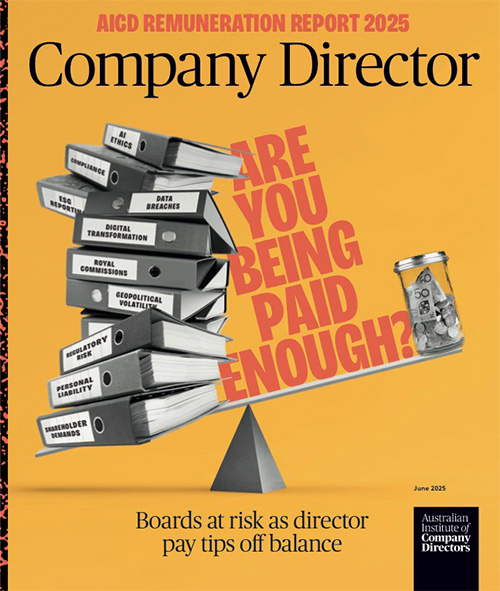Boards are a human business and no-one can be blemish-free, writes Robyn Weatherley AAICD, author of Eyes Wide Open: A First Timer’s Guide to the Real World of Boards and Company Directorship.
1. A board needs to be able to make the hard calls
The inability to manage interpersonal conflict has undone the careers of many an eminent chair, board and CEO. The longer you leave it and labour the decision, the harder it will be to execute on the call.
My interviewees tell me boards can be exceptionally difficult spaces to operate in, given the messy intersection of human and corporate complexities. But if you’re not comfortable working in environments involving sometimes difficult and high-stakes decision-making, you should reconsider a board career.
2. No board is ever without a problem, even if it thinks it has none
For one recent interviewee, a previously unknown risk emerged blindingly quickly when the board realised one of the company’s businesses was unsustainable and needed to be sold or wound up without delay. This realisation came late into the board’s strategic plan, with inaction likely to reduce the value of the business to be sold.
The board, operating by habit, had historically focused on the over-arching macro profitability of the entire entity, as presented by the CEO at each board meeting. It had not sufficiently dissected and understood each of the separate operating businesses — their strengths, capital positions, interdependencies and sources of cashflow. Remember for your board reporting that when the fields appear green and wide, there may sometimes be an underlying secret to be spied.
3. Tenacious curiosity is your best friend
This is a critical element of successful boards and great directors, and its absence can be costly. If your board is being asked to decide on something you don’t understand, you must remain insatiably curious and driven to unpack what is unclear until this opacity is resolved.
My interviewees’ advice was to cultivate a practice whereby you don’t give in to peer pressure. Doing this as a new director can be challenging and may involve calling out clear and present dangers in an organisation’s biggest and most expensive strategy. But it can and has been done. One must be willing and able to challenge the decisions — and sometimes arrogance — of embedded, high-profile director peers while still being relatively new to the board table. It’s not an easy feat, but this is an essential characteristic to acquire to add value to boards — and to underpin your reputation and integrity.
4. Speed can be expensive and a red flag
If something is being pushed onto the board by management — say a limited opportunity or a decision to be made quickly — directors must deeply challenge their rationale for speed. What are the drivers of the “rush”? What’s in it for management to get this done quickly?
My interviewees also agreed that all significant, entity-transforming strategic decisions by boards should include a “pre-mortem”. Directors should review and interrogate an opportunity with vulnerability and openness, identifying all the things that could go wrong and what that would mean for the company — as well as employees, financial stability and stakeholders — and pondering the result. Critically, this process should be undertaken before the board makes the decision and must also include what could happen if the board doesn’t proceed.
5. Don’t allow the tail to wag the dog
A CEO seeking to unduly influence a board for his or her own gain or interests rarely ends well. Shareholder value and a company’s reputation can be materially at risk if a CEO and board relationship does not have the requisite level of respect, challenge and tension.
Directors are often compelled to act when they recognise a chair and CEO as unusually close, when a blind eye is turned to inferior CEO performance, or a CEO’s dominance is consistently and blatantly enabled by the chair or a clique of directors.
A further canary in the coal mine is when you observe a CEO being repeatedly dismissive, patronising or admonishing of the board.
CEOs who treat boards as roadblocks or something to “put up with” are waving a behavioural flag. If that is how they treat the board, imagine what happens within the organisation they lead.
Disclaimer: This article reflects the work of Robyn Weatherley in her private capacity and has no connection of any kind to her employer or its views on any of the topics covered.
This article first appeared under the headline 'Peak Performance’ in the May 2025 issue of Company Director magazine.
Latest news
Already a member?
Login to view this content



